Universal Basic Income and Health Determinants in Australia
VerifiedAdded on 2022/08/20
|12
|2401
|15
Essay
AI Summary
This essay delves into the intersection of Universal Basic Income (UBI) and health within the Australian context. It explores how UBI, defined as an unconditional income provided to all citizens, could influence health policies and address social determinants of health such as income, employment, education, and housing. The paper examines the Australian healthcare system, highlighting the roles of federal, state, and private entities, and emphasizes the significance of social determinants, including economic stability, and health equity. It investigates the potential of UBI to mitigate health inequities stemming from unemployment and income disparities, while acknowledging the existing debates regarding its effectiveness in health interventions. The essay concludes by emphasizing the integral link between health, social determinants, and governmental strategies, positioning UBI as a potential tool for public health and financial interventions, while also acknowledging the need for further research on its actual impacts.

Running head: UNIVERSAL BASIC INCOME
Universal Basic Income and Social Determinants of Health
Name of the Student
Name of the University
Author Note
Universal Basic Income and Social Determinants of Health
Name of the Student
Name of the University
Author Note
Secure Best Marks with AI Grader
Need help grading? Try our AI Grader for instant feedback on your assignments.
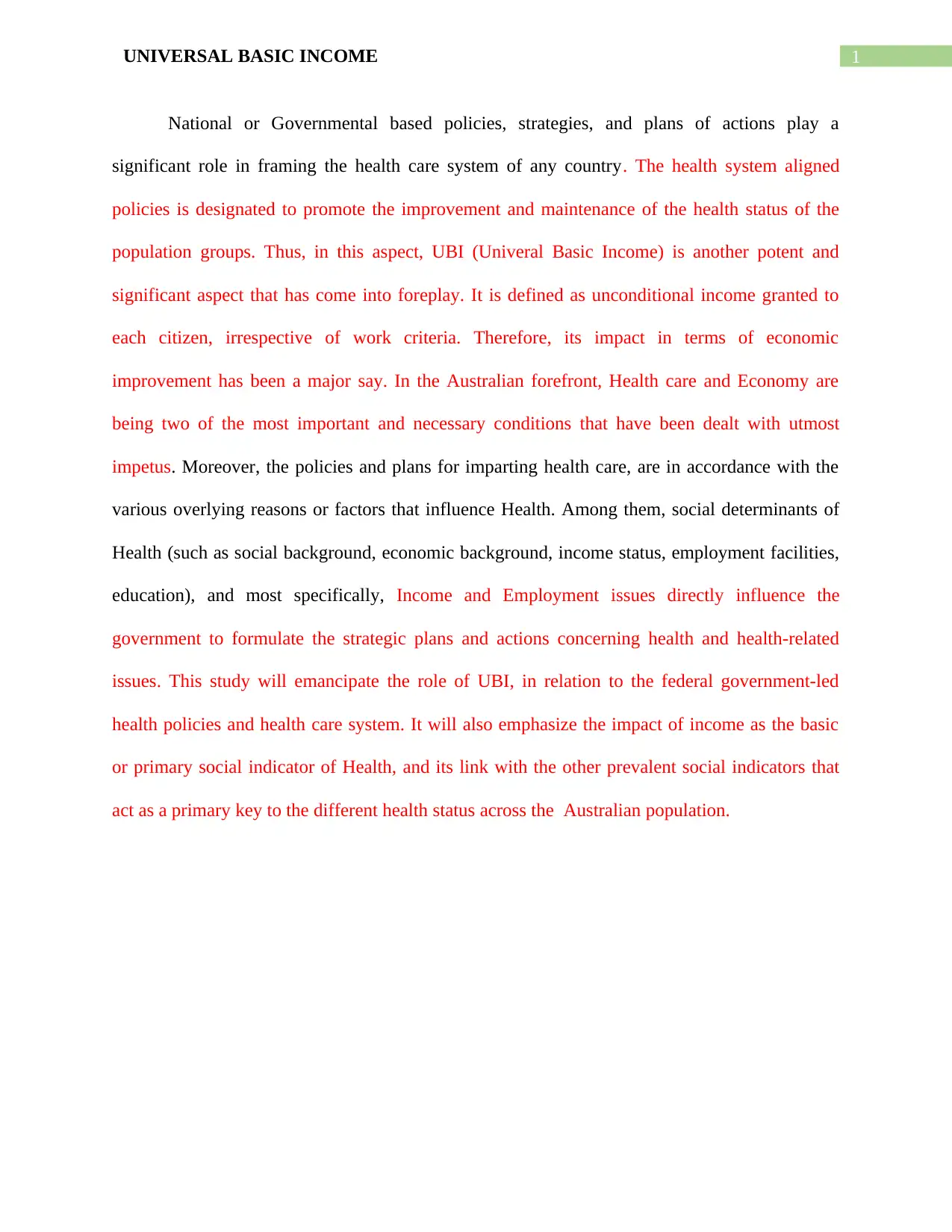
1UNIVERSAL BASIC INCOME
National or Governmental based policies, strategies, and plans of actions play a
significant role in framing the health care system of any country. The health system aligned
policies is designated to promote the improvement and maintenance of the health status of the
population groups. Thus, in this aspect, UBI (Univeral Basic Income) is another potent and
significant aspect that has come into foreplay. It is defined as unconditional income granted to
each citizen, irrespective of work criteria. Therefore, its impact in terms of economic
improvement has been a major say. In the Australian forefront, Health care and Economy are
being two of the most important and necessary conditions that have been dealt with utmost
impetus. Moreover, the policies and plans for imparting health care, are in accordance with the
various overlying reasons or factors that influence Health. Among them, social determinants of
Health (such as social background, economic background, income status, employment facilities,
education), and most specifically, Income and Employment issues directly influence the
government to formulate the strategic plans and actions concerning health and health-related
issues. This study will emancipate the role of UBI, in relation to the federal government-led
health policies and health care system. It will also emphasize the impact of income as the basic
or primary social indicator of Health, and its link with the other prevalent social indicators that
act as a primary key to the different health status across the Australian population.
National or Governmental based policies, strategies, and plans of actions play a
significant role in framing the health care system of any country. The health system aligned
policies is designated to promote the improvement and maintenance of the health status of the
population groups. Thus, in this aspect, UBI (Univeral Basic Income) is another potent and
significant aspect that has come into foreplay. It is defined as unconditional income granted to
each citizen, irrespective of work criteria. Therefore, its impact in terms of economic
improvement has been a major say. In the Australian forefront, Health care and Economy are
being two of the most important and necessary conditions that have been dealt with utmost
impetus. Moreover, the policies and plans for imparting health care, are in accordance with the
various overlying reasons or factors that influence Health. Among them, social determinants of
Health (such as social background, economic background, income status, employment facilities,
education), and most specifically, Income and Employment issues directly influence the
government to formulate the strategic plans and actions concerning health and health-related
issues. This study will emancipate the role of UBI, in relation to the federal government-led
health policies and health care system. It will also emphasize the impact of income as the basic
or primary social indicator of Health, and its link with the other prevalent social indicators that
act as a primary key to the different health status across the Australian population.
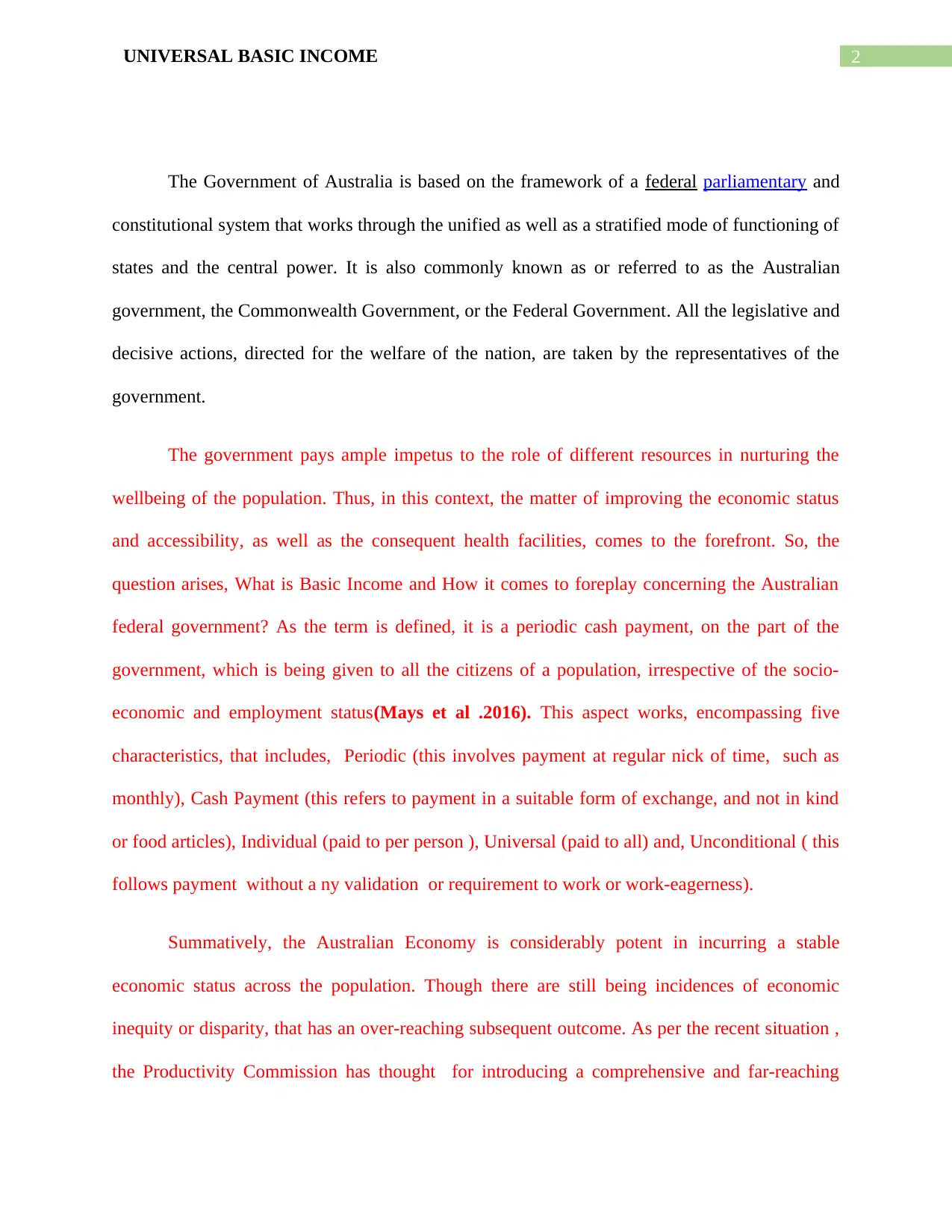
2UNIVERSAL BASIC INCOME
The Government of Australia is based on the framework of a federal parliamentary and
constitutional system that works through the unified as well as a stratified mode of functioning of
states and the central power. It is also commonly known as or referred to as the Australian
government, the Commonwealth Government, or the Federal Government. All the legislative and
decisive actions, directed for the welfare of the nation, are taken by the representatives of the
government.
The government pays ample impetus to the role of different resources in nurturing the
wellbeing of the population. Thus, in this context, the matter of improving the economic status
and accessibility, as well as the consequent health facilities, comes to the forefront. So, the
question arises, What is Basic Income and How it comes to foreplay concerning the Australian
federal government? As the term is defined, it is a periodic cash payment, on the part of the
government, which is being given to all the citizens of a population, irrespective of the socio-
economic and employment status(Mays et al .2016). This aspect works, encompassing five
characteristics, that includes, Periodic (this involves payment at regular nick of time, such as
monthly), Cash Payment (this refers to payment in a suitable form of exchange, and not in kind
or food articles), Individual (paid to per person ), Universal (paid to all) and, Unconditional ( this
follows payment without a ny validation or requirement to work or work-eagerness).
Summatively, the Australian Economy is considerably potent in incurring a stable
economic status across the population. Though there are still being incidences of economic
inequity or disparity, that has an over-reaching subsequent outcome. As per the recent situation ,
the Productivity Commission has thought for introducing a comprehensive and far-reaching
The Government of Australia is based on the framework of a federal parliamentary and
constitutional system that works through the unified as well as a stratified mode of functioning of
states and the central power. It is also commonly known as or referred to as the Australian
government, the Commonwealth Government, or the Federal Government. All the legislative and
decisive actions, directed for the welfare of the nation, are taken by the representatives of the
government.
The government pays ample impetus to the role of different resources in nurturing the
wellbeing of the population. Thus, in this context, the matter of improving the economic status
and accessibility, as well as the consequent health facilities, comes to the forefront. So, the
question arises, What is Basic Income and How it comes to foreplay concerning the Australian
federal government? As the term is defined, it is a periodic cash payment, on the part of the
government, which is being given to all the citizens of a population, irrespective of the socio-
economic and employment status(Mays et al .2016). This aspect works, encompassing five
characteristics, that includes, Periodic (this involves payment at regular nick of time, such as
monthly), Cash Payment (this refers to payment in a suitable form of exchange, and not in kind
or food articles), Individual (paid to per person ), Universal (paid to all) and, Unconditional ( this
follows payment without a ny validation or requirement to work or work-eagerness).
Summatively, the Australian Economy is considerably potent in incurring a stable
economic status across the population. Though there are still being incidences of economic
inequity or disparity, that has an over-reaching subsequent outcome. As per the recent situation ,
the Productivity Commission has thought for introducing a comprehensive and far-reaching
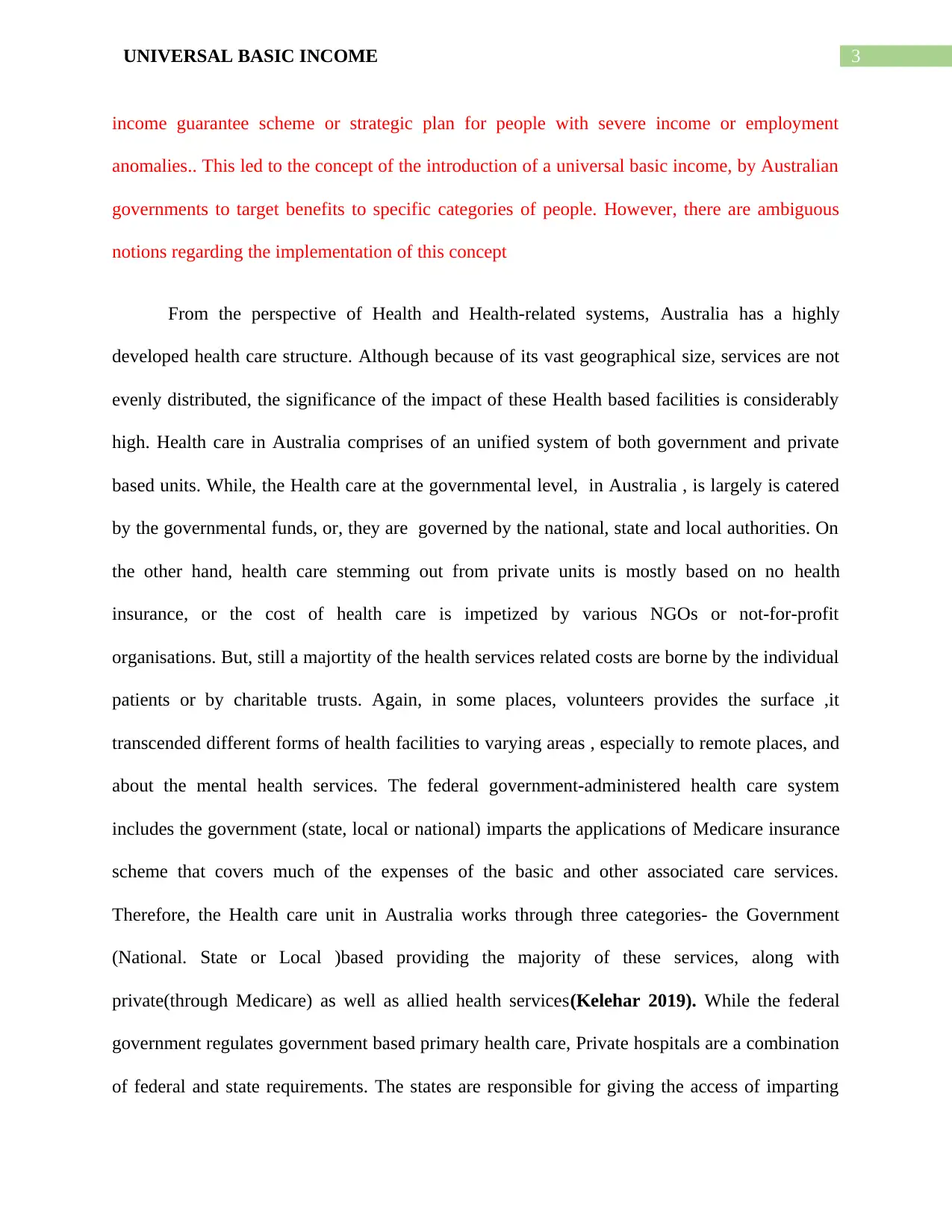
3UNIVERSAL BASIC INCOME
income guarantee scheme or strategic plan for people with severe income or employment
anomalies.. This led to the concept of the introduction of a universal basic income, by Australian
governments to target benefits to specific categories of people. However, there are ambiguous
notions regarding the implementation of this concept
From the perspective of Health and Health-related systems, Australia has a highly
developed health care structure. Although because of its vast geographical size, services are not
evenly distributed, the significance of the impact of these Health based facilities is considerably
high. Health care in Australia comprises of an unified system of both government and private
based units. While, the Health care at the governmental level, in Australia , is largely is catered
by the governmental funds, or, they are governed by the national, state and local authorities. On
the other hand, health care stemming out from private units is mostly based on no health
insurance, or the cost of health care is impetized by various NGOs or not-for-profit
organisations. But, still a majortity of the health services related costs are borne by the individual
patients or by charitable trusts. Again, in some places, volunteers provides the surface ,it
transcended different forms of health facilities to varying areas , especially to remote places, and
about the mental health services. The federal government-administered health care system
includes the government (state, local or national) imparts the applications of Medicare insurance
scheme that covers much of the expenses of the basic and other associated care services.
Therefore, the Health care unit in Australia works through three categories- the Government
(National. State or Local )based providing the majority of these services, along with
private(through Medicare) as well as allied health services(Kelehar 2019). While the federal
government regulates government based primary health care, Private hospitals are a combination
of federal and state requirements. The states are responsible for giving the access of imparting
income guarantee scheme or strategic plan for people with severe income or employment
anomalies.. This led to the concept of the introduction of a universal basic income, by Australian
governments to target benefits to specific categories of people. However, there are ambiguous
notions regarding the implementation of this concept
From the perspective of Health and Health-related systems, Australia has a highly
developed health care structure. Although because of its vast geographical size, services are not
evenly distributed, the significance of the impact of these Health based facilities is considerably
high. Health care in Australia comprises of an unified system of both government and private
based units. While, the Health care at the governmental level, in Australia , is largely is catered
by the governmental funds, or, they are governed by the national, state and local authorities. On
the other hand, health care stemming out from private units is mostly based on no health
insurance, or the cost of health care is impetized by various NGOs or not-for-profit
organisations. But, still a majortity of the health services related costs are borne by the individual
patients or by charitable trusts. Again, in some places, volunteers provides the surface ,it
transcended different forms of health facilities to varying areas , especially to remote places, and
about the mental health services. The federal government-administered health care system
includes the government (state, local or national) imparts the applications of Medicare insurance
scheme that covers much of the expenses of the basic and other associated care services.
Therefore, the Health care unit in Australia works through three categories- the Government
(National. State or Local )based providing the majority of these services, along with
private(through Medicare) as well as allied health services(Kelehar 2019). While the federal
government regulates government based primary health care, Private hospitals are a combination
of federal and state requirements. The states are responsible for giving the access of imparting
Secure Best Marks with AI Grader
Need help grading? Try our AI Grader for instant feedback on your assignments.

4UNIVERSAL BASIC INCOME
health related services to the private hospitals, while the federal government act as a regulator for
the private health insurance. The australian health system and the policy framework, has
achieved good results with an overall improvement in life expectancy of the population. Also , as
per the reports of OECD (Organisation for Economic Co-operation and Development)the
expenses related to health. in Australia is about the same as that of the standardized average,
which further sheds light on the impact of the health unit and that of the aligned policies. Thus, it
can be said that one of the central focus of the federal government of Australia is to minimize the
gap between Health and Economy, as the latter is one of the integral Social Determinants of
Health (SDHs).
The concept of Social determinants of Health exert a signficant impact on the
extent of the effectiveness of these health based services and policies. Factors such as income,
education, conditions of employment, power and social support, because of their potent roles as
the health-determining factors are considered to be the ‘social determinants of health.( Green,
Dickinson, and Carey, 2019). The World Health Organization (WHO) has described social
determinants as “ the circumstances in which people grow, live, work, and age, and the systems
put in place to deal with illness. The conditions in which people live and die are, in turn, shaped
by political, social, and economic forces”. Thus , these social factors that affects health can be
also considered to be the foundational determinants or as said , the “ causes of the causes ”, as
they set the basis for the core indicators of health (Browne-Yung et al.2018). These social
determinants are an array of the influencing factors present in the vicinity of an individual, that
shapes and modulates health conditions. They are often aligned interchangeably with Socio-
Economic Power (SEP)(Browne-Yung et al.2018). The underlying influence of these indicators
health related services to the private hospitals, while the federal government act as a regulator for
the private health insurance. The australian health system and the policy framework, has
achieved good results with an overall improvement in life expectancy of the population. Also , as
per the reports of OECD (Organisation for Economic Co-operation and Development)the
expenses related to health. in Australia is about the same as that of the standardized average,
which further sheds light on the impact of the health unit and that of the aligned policies. Thus, it
can be said that one of the central focus of the federal government of Australia is to minimize the
gap between Health and Economy, as the latter is one of the integral Social Determinants of
Health (SDHs).
The concept of Social determinants of Health exert a signficant impact on the
extent of the effectiveness of these health based services and policies. Factors such as income,
education, conditions of employment, power and social support, because of their potent roles as
the health-determining factors are considered to be the ‘social determinants of health.( Green,
Dickinson, and Carey, 2019). The World Health Organization (WHO) has described social
determinants as “ the circumstances in which people grow, live, work, and age, and the systems
put in place to deal with illness. The conditions in which people live and die are, in turn, shaped
by political, social, and economic forces”. Thus , these social factors that affects health can be
also considered to be the foundational determinants or as said , the “ causes of the causes ”, as
they set the basis for the core indicators of health (Browne-Yung et al.2018). These social
determinants are an array of the influencing factors present in the vicinity of an individual, that
shapes and modulates health conditions. They are often aligned interchangeably with Socio-
Economic Power (SEP)(Browne-Yung et al.2018). The underlying influence of these indicators
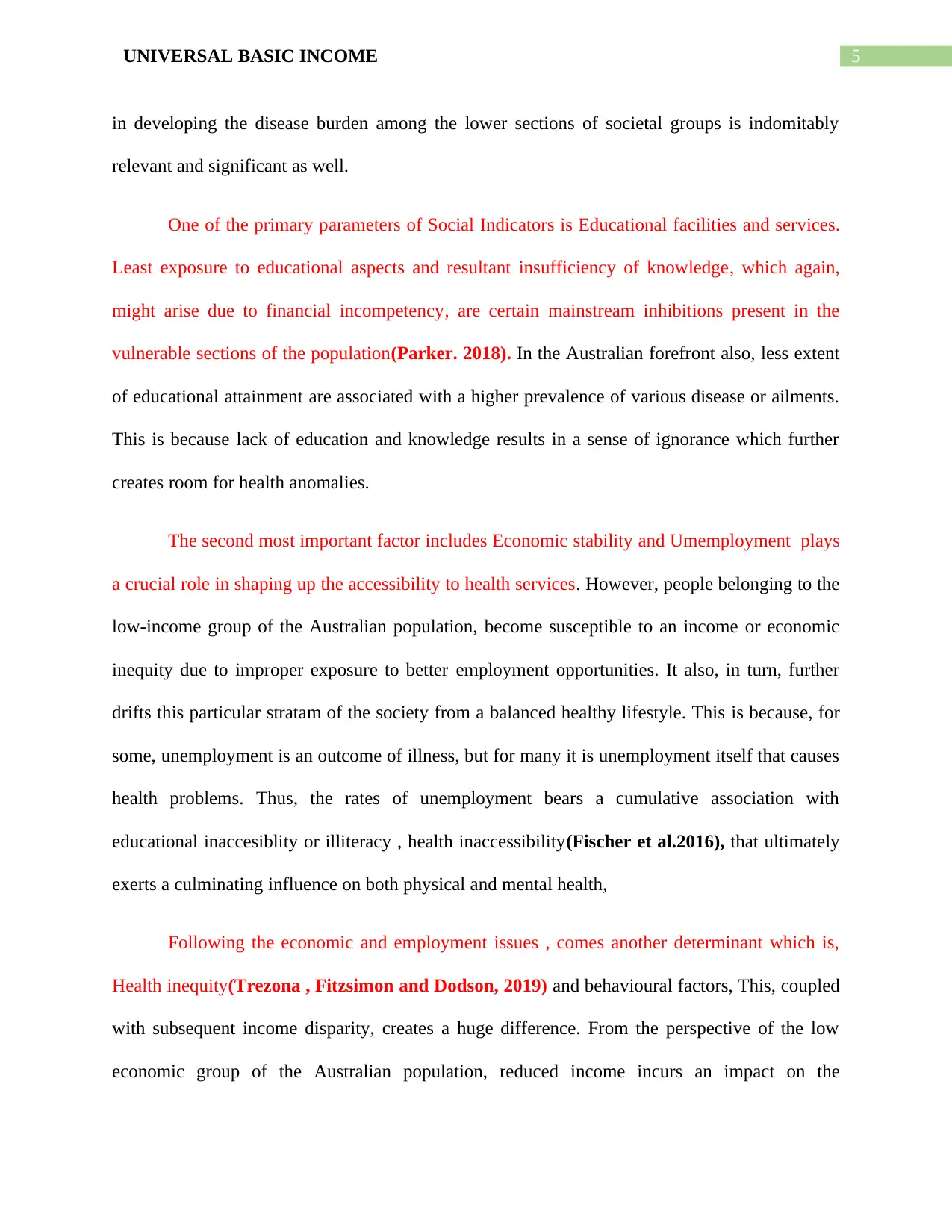
5UNIVERSAL BASIC INCOME
in developing the disease burden among the lower sections of societal groups is indomitably
relevant and significant as well.
One of the primary parameters of Social Indicators is Educational facilities and services.
Least exposure to educational aspects and resultant insufficiency of knowledge, which again,
might arise due to financial incompetency, are certain mainstream inhibitions present in the
vulnerable sections of the population(Parker. 2018). In the Australian forefront also, less extent
of educational attainment are associated with a higher prevalence of various disease or ailments.
This is because lack of education and knowledge results in a sense of ignorance which further
creates room for health anomalies.
The second most important factor includes Economic stability and Umemployment plays
a crucial role in shaping up the accessibility to health services. However, people belonging to the
low-income group of the Australian population, become susceptible to an income or economic
inequity due to improper exposure to better employment opportunities. It also, in turn, further
drifts this particular stratam of the society from a balanced healthy lifestyle. This is because, for
some, unemployment is an outcome of illness, but for many it is unemployment itself that causes
health problems. Thus, the rates of unemployment bears a cumulative association with
educational inaccesiblity or illiteracy , health inaccessibility(Fischer et al.2016), that ultimately
exerts a culminating influence on both physical and mental health,
Following the economic and employment issues , comes another determinant which is,
Health inequity(Trezona , Fitzsimon and Dodson, 2019) and behavioural factors, This, coupled
with subsequent income disparity, creates a huge difference. From the perspective of the low
economic group of the Australian population, reduced income incurs an impact on the
in developing the disease burden among the lower sections of societal groups is indomitably
relevant and significant as well.
One of the primary parameters of Social Indicators is Educational facilities and services.
Least exposure to educational aspects and resultant insufficiency of knowledge, which again,
might arise due to financial incompetency, are certain mainstream inhibitions present in the
vulnerable sections of the population(Parker. 2018). In the Australian forefront also, less extent
of educational attainment are associated with a higher prevalence of various disease or ailments.
This is because lack of education and knowledge results in a sense of ignorance which further
creates room for health anomalies.
The second most important factor includes Economic stability and Umemployment plays
a crucial role in shaping up the accessibility to health services. However, people belonging to the
low-income group of the Australian population, become susceptible to an income or economic
inequity due to improper exposure to better employment opportunities. It also, in turn, further
drifts this particular stratam of the society from a balanced healthy lifestyle. This is because, for
some, unemployment is an outcome of illness, but for many it is unemployment itself that causes
health problems. Thus, the rates of unemployment bears a cumulative association with
educational inaccesiblity or illiteracy , health inaccessibility(Fischer et al.2016), that ultimately
exerts a culminating influence on both physical and mental health,
Following the economic and employment issues , comes another determinant which is,
Health inequity(Trezona , Fitzsimon and Dodson, 2019) and behavioural factors, This, coupled
with subsequent income disparity, creates a huge difference. From the perspective of the low
economic group of the Australian population, reduced income incurs an impact on the
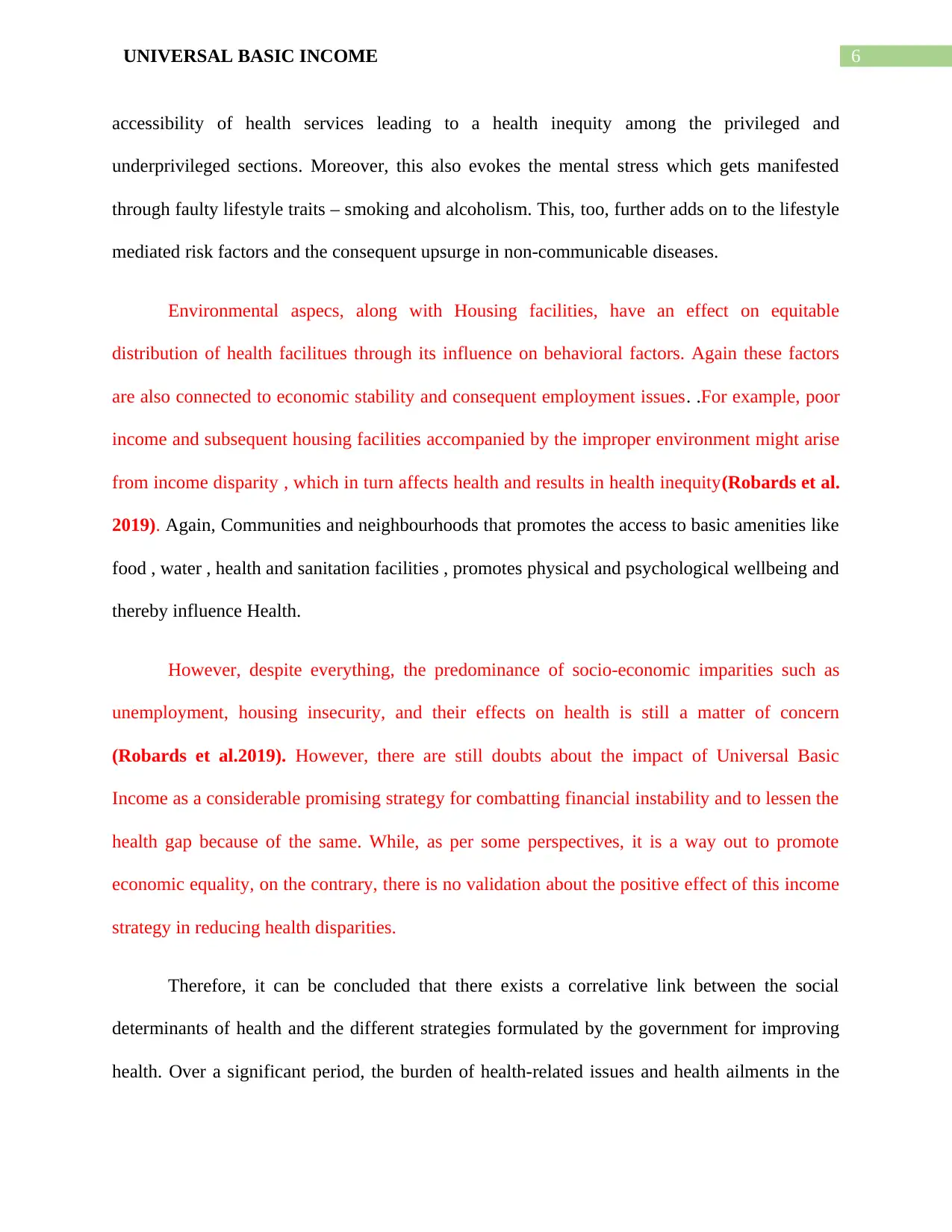
6UNIVERSAL BASIC INCOME
accessibility of health services leading to a health inequity among the privileged and
underprivileged sections. Moreover, this also evokes the mental stress which gets manifested
through faulty lifestyle traits – smoking and alcoholism. This, too, further adds on to the lifestyle
mediated risk factors and the consequent upsurge in non-communicable diseases.
Environmental aspecs, along with Housing facilities, have an effect on equitable
distribution of health facilitues through its influence on behavioral factors. Again these factors
are also connected to economic stability and consequent employment issues. .For example, poor
income and subsequent housing facilities accompanied by the improper environment might arise
from income disparity , which in turn affects health and results in health inequity(Robards et al.
2019). Again, Communities and neighbourhoods that promotes the access to basic amenities like
food , water , health and sanitation facilities , promotes physical and psychological wellbeing and
thereby influence Health.
However, despite everything, the predominance of socio-economic imparities such as
unemployment, housing insecurity, and their effects on health is still a matter of concern
(Robards et al.2019). However, there are still doubts about the impact of Universal Basic
Income as a considerable promising strategy for combatting financial instability and to lessen the
health gap because of the same. While, as per some perspectives, it is a way out to promote
economic equality, on the contrary, there is no validation about the positive effect of this income
strategy in reducing health disparities.
Therefore, it can be concluded that there exists a correlative link between the social
determinants of health and the different strategies formulated by the government for improving
health. Over a significant period, the burden of health-related issues and health ailments in the
accessibility of health services leading to a health inequity among the privileged and
underprivileged sections. Moreover, this also evokes the mental stress which gets manifested
through faulty lifestyle traits – smoking and alcoholism. This, too, further adds on to the lifestyle
mediated risk factors and the consequent upsurge in non-communicable diseases.
Environmental aspecs, along with Housing facilities, have an effect on equitable
distribution of health facilitues through its influence on behavioral factors. Again these factors
are also connected to economic stability and consequent employment issues. .For example, poor
income and subsequent housing facilities accompanied by the improper environment might arise
from income disparity , which in turn affects health and results in health inequity(Robards et al.
2019). Again, Communities and neighbourhoods that promotes the access to basic amenities like
food , water , health and sanitation facilities , promotes physical and psychological wellbeing and
thereby influence Health.
However, despite everything, the predominance of socio-economic imparities such as
unemployment, housing insecurity, and their effects on health is still a matter of concern
(Robards et al.2019). However, there are still doubts about the impact of Universal Basic
Income as a considerable promising strategy for combatting financial instability and to lessen the
health gap because of the same. While, as per some perspectives, it is a way out to promote
economic equality, on the contrary, there is no validation about the positive effect of this income
strategy in reducing health disparities.
Therefore, it can be concluded that there exists a correlative link between the social
determinants of health and the different strategies formulated by the government for improving
health. Over a significant period, the burden of health-related issues and health ailments in the
Paraphrase This Document
Need a fresh take? Get an instant paraphrase of this document with our AI Paraphraser

7UNIVERSAL BASIC INCOME
Australian population has been connected to the varying social factors such as lack of education
and health illiteracy, unemployment, economic constraints and environmental disparities. Thus,
in this aspect, universal basic income was thought of, as one of a potent key to incur public
health as well as financial interventions. However, there is still a question about its said
implications in health interventions. Although, in spite of this, it can be noted that Health, Social
Determinants, or more specifically , Income and Employment, and the Implementing
governmental sector is one and integral unit.
Australian population has been connected to the varying social factors such as lack of education
and health illiteracy, unemployment, economic constraints and environmental disparities. Thus,
in this aspect, universal basic income was thought of, as one of a potent key to incur public
health as well as financial interventions. However, there is still a question about its said
implications in health interventions. Although, in spite of this, it can be noted that Health, Social
Determinants, or more specifically , Income and Employment, and the Implementing
governmental sector is one and integral unit.
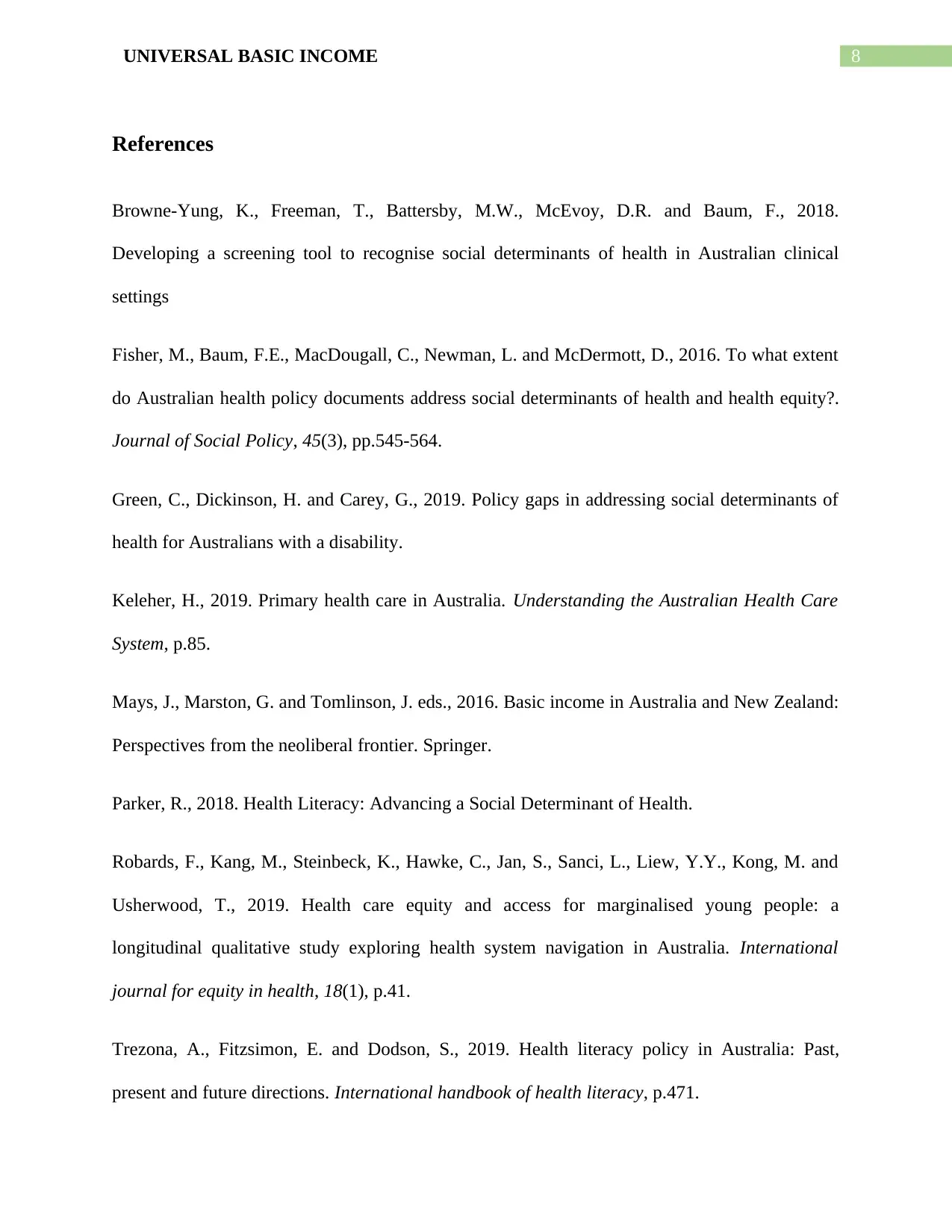
8UNIVERSAL BASIC INCOME
References
Browne-Yung, K., Freeman, T., Battersby, M.W., McEvoy, D.R. and Baum, F., 2018.
Developing a screening tool to recognise social determinants of health in Australian clinical
settings
Fisher, M., Baum, F.E., MacDougall, C., Newman, L. and McDermott, D., 2016. To what extent
do Australian health policy documents address social determinants of health and health equity?.
Journal of Social Policy, 45(3), pp.545-564.
Green, C., Dickinson, H. and Carey, G., 2019. Policy gaps in addressing social determinants of
health for Australians with a disability.
Keleher, H., 2019. Primary health care in Australia. Understanding the Australian Health Care
System, p.85.
Mays, J., Marston, G. and Tomlinson, J. eds., 2016. Basic income in Australia and New Zealand:
Perspectives from the neoliberal frontier. Springer.
Parker, R., 2018. Health Literacy: Advancing a Social Determinant of Health.
Robards, F., Kang, M., Steinbeck, K., Hawke, C., Jan, S., Sanci, L., Liew, Y.Y., Kong, M. and
Usherwood, T., 2019. Health care equity and access for marginalised young people: a
longitudinal qualitative study exploring health system navigation in Australia. International
journal for equity in health, 18(1), p.41.
Trezona, A., Fitzsimon, E. and Dodson, S., 2019. Health literacy policy in Australia: Past,
present and future directions. International handbook of health literacy, p.471.
References
Browne-Yung, K., Freeman, T., Battersby, M.W., McEvoy, D.R. and Baum, F., 2018.
Developing a screening tool to recognise social determinants of health in Australian clinical
settings
Fisher, M., Baum, F.E., MacDougall, C., Newman, L. and McDermott, D., 2016. To what extent
do Australian health policy documents address social determinants of health and health equity?.
Journal of Social Policy, 45(3), pp.545-564.
Green, C., Dickinson, H. and Carey, G., 2019. Policy gaps in addressing social determinants of
health for Australians with a disability.
Keleher, H., 2019. Primary health care in Australia. Understanding the Australian Health Care
System, p.85.
Mays, J., Marston, G. and Tomlinson, J. eds., 2016. Basic income in Australia and New Zealand:
Perspectives from the neoliberal frontier. Springer.
Parker, R., 2018. Health Literacy: Advancing a Social Determinant of Health.
Robards, F., Kang, M., Steinbeck, K., Hawke, C., Jan, S., Sanci, L., Liew, Y.Y., Kong, M. and
Usherwood, T., 2019. Health care equity and access for marginalised young people: a
longitudinal qualitative study exploring health system navigation in Australia. International
journal for equity in health, 18(1), p.41.
Trezona, A., Fitzsimon, E. and Dodson, S., 2019. Health literacy policy in Australia: Past,
present and future directions. International handbook of health literacy, p.471.

9UNIVERSAL BASIC INCOME
Secure Best Marks with AI Grader
Need help grading? Try our AI Grader for instant feedback on your assignments.

10UNIVERSAL BASIC INCOME

11UNIVERSAL BASIC INCOME
1 out of 12
Related Documents
Your All-in-One AI-Powered Toolkit for Academic Success.
+13062052269
info@desklib.com
Available 24*7 on WhatsApp / Email
![[object Object]](/_next/static/media/star-bottom.7253800d.svg)
Unlock your academic potential
© 2024 | Zucol Services PVT LTD | All rights reserved.





